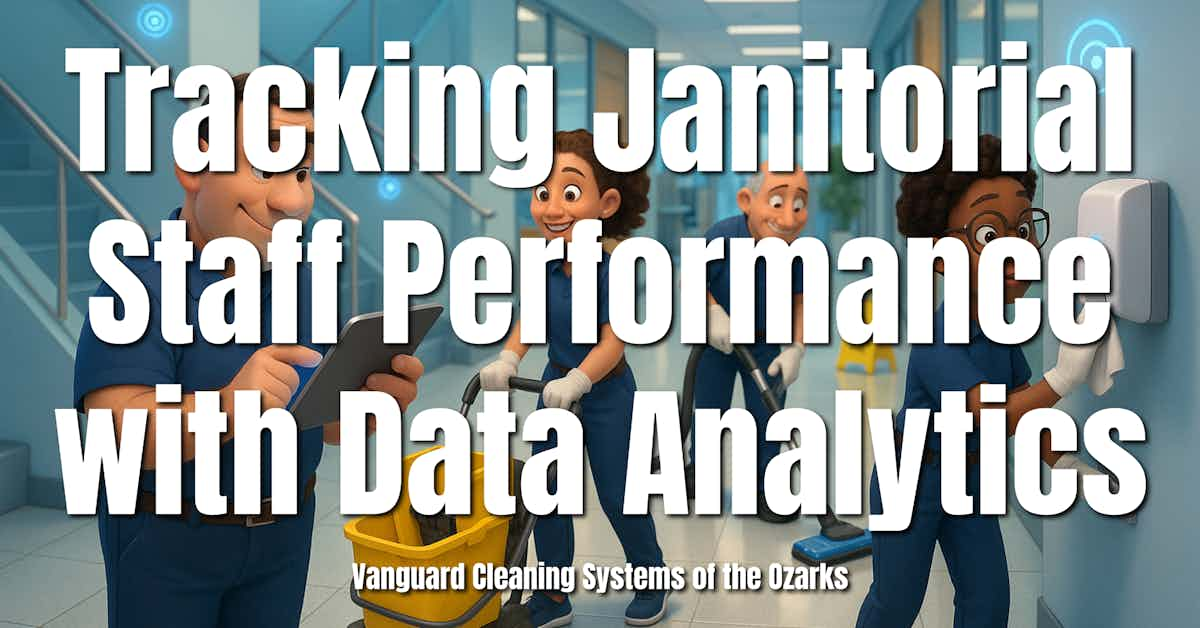Data analytics is transforming janitorial work from invisible labor into a measurable driver of health, efficiency, and retention.
![]()
The Rising Role of Data Analytics in Janitorial Performance
Janitorial services are critical to the safe, efficient, and hygienic operation of hospitals, schools, offices, and industrial facilities. Their work directly affects infection control, employee health, customer satisfaction, and regulatory compliance. Despite this importance, performance measurement of janitorial staff has often relied on subjective supervisor observations, customer complaints, or basic time-tracking systems. These methods fail to provide actionable, objective, and reliable data.
The integration of data analytics provides an opportunity to transform janitorial workforce management from a reactive process to a proactive, evidence-based system. Recent studies demonstrate links between staff turnover, job satisfaction, ergonomics, and cleaning outcomes. At the same time, technology such as wearables, Internet of Things (IoT) sensors, and digital dashboards has matured enough to support real-time performance monitoring.
This article provides a comprehensive review of how data analytics can be applied to track janitorial staff performance. It evaluates research findings, highlights key performance indicators (KPIs), explores analytical methods, and proposes an implementation framework.
The State of Janitorial Performance Measurement
Traditional Methods
Historically, janitorial staff were evaluated through visual inspections, customer complaints, and labor-hour reports. While simple, these methods lack objectivity, consistency, and outcome alignment.
Evidence-Based Cleaning Standards
Over the last two decades, frameworks have emerged to standardize cleaning outcomes. The Association of Physical Plant Administrators (APPA) defined five levels of cleanliness, ranging from Level 1 (orderly spotlessness) to Level 5 (neglect) [1]. The International Sanitary Supply Association (ISSA) developed the Cleaning Industry Management Standard (CIMS), emphasizing documented systems, audits, and performance reviews [2]. The Centers for Disease Control and Prevention (CDC) issued evaluation toolkits recommending fluorescent markers, ATP bioluminescence, and direct observation as objective measures [3].
Global Variation
Hospitals in Pakistan, SMEs in Peru, and tertiary care facilities in Sri Lanka demonstrate wide variability in how performance is monitored. Some rely heavily on outsourcing with limited quality control, while others maintain in-house staff but lack structured performance appraisals [4–6]. These findings highlight the need for adaptable, data-driven systems capable of ensuring consistent quality regardless of organizational context.
Evidence from Research Studies
Turnover and Performance
A 2023 Peruvian study found a moderate positive correlation between staff turnover and job performance (r ≈ 0.36), with similar correlations for both voluntary and involuntary turnover [6]. This suggests performance metrics can be predictive of workforce stability.
Job Satisfaction and Performance
A Sri Lankan hospital study in 2024 identified income satisfaction, facilities, and colleague support as major determinants of job satisfaction, which directly influenced janitorial staff performance [5]. Weaknesses in monitoring and supervisory systems were also observed.
Ergonomics and Work Pace
Wearables used in a U.S. study revealed that faster work pace increased physiological strain and poor trunk posture among janitors, raising risks of fatigue and injury [7]. This underscores the value of ergonomic data in balancing workloads.
Online Performance Tracking Models
Ardil and Bilgen (2017) presented an entropy-based weighted sum model integrating multiple performance criteria such as work quality, cooperation, and willingness into composite scores [8]. The framework demonstrated how multi-criteria decision analysis (MCDA) can be used to rank staff objectively.
SOP Adherence and Training
Pakistani hospital research highlighted the importance of standard operating procedures (SOPs), audits, and training in maintaining quality. Facilities with more structured monitoring achieved stronger performance despite staffing shortages [4].
What to Measure: Key Performance Indicators
Outcome Quality
- APPA levels of cleanliness [1]
- Cleaning validation using fluorescent markers and ATP swabs [3]
- Complaint rate per 100,000 square feet
- First-pass yield (spaces cleaned correctly on first attempt)
Process Metrics
- Planned vs. completed tasks
- Average response time to service requests
- Route efficiency (active cleaning vs. transit time)
- SOP adherence rates
HR and Engagement Metrics
- Turnover rates (voluntary and involuntary) [6]
- Absenteeism rates
- Job satisfaction survey results [5]
- Peer support and teamwork indices
Ergonomics and Safety
- Posture deviations per shift [7]
- Heart rate and strain monitoring
- Injury and near-miss reporting
Cost and Resource Efficiency
- Labor cost per cleanable square foot (benchmark vs. IFMA/BOMA) [9]
- Supply efficiency (usage vs. predicted consumption)
- Overtime ratios
Data Sources and Technologies
- Audits and Checklists: APPA and ISSA-aligned tools digitized via mobile apps.
- IoT Sensors: Occupancy counters, smart dispensers, and environmental sensors.
- Wearables: Pedometers, posture monitors, and heart rate trackers.
- HR Systems: Turnover, absenteeism, and satisfaction survey data.
- CMMS/BI Dashboards: Integrated platforms for cleaning task management and reporting.
Analytical Models for Performance Tracking
- Descriptive analytics: Dashboards with daily/weekly KPIs.
- Diagnostic analytics: Root cause analysis for recurring service failures.
- Predictive analytics: Forecast turnover, absenteeism, and workload surges.
- Prescriptive analytics: Dynamic staff scheduling and resource allocation.
- Entropy-weighted composite scores: Combining multiple indicators into a balanced ranking [8].
Organizational Outcomes
- Reduced turnover and absenteeism [6].
- Higher job satisfaction and retention [5].
- Better infection control through SOP adherence [4].
- Labor efficiency gains benchmarked with IFMA/BOMA [9].
- Reduced injuries via ergonomic monitoring [7].
- Improved accountability under performance-based contracts [2].
Ethical, Legal, and Privacy Considerations
Monitoring raises concerns about worker privacy and autonomy. Regulations such as GDPR in Europe and CPRA in California require clear disclosure, limited data use, and employee rights to review their data. The NIST AI Risk Management Framework provides guidance on transparency, fairness, and accountability in algorithmic systems [10].
Implementation Framework
- Define Standards: Map spaces to APPA levels, set KPIs, and publish a data dictionary.
- Instrument & Integrate: Deploy audits, IoT sensors, and HR linkages.
- Baseline & Benchmark: Collect 4–6 weeks of baseline data, benchmark against IFMA/BOMA.
- Analytics Deployment: Build dashboards, predictive models, and dynamic scheduling pilots.
- Continuous Improvement: Train staff, refine metrics, and align incentives with outcomes.
Barriers and Pitfalls
- Data overload without clear KPIs.
- Misapplication of ATP thresholds [3].
- Overemphasis on speed (Goodhart’s Law).
- Outsourcing cost pressures vs. quality [4].
- Employee resistance to monitoring unless positioned as supportive [5].
Future Directions
- AI-driven workload optimization.
- Integration with ESG and sustainability reporting.
- Linking performance data to measurable health outcomes.
- Shared benchmarking across industries.
Conclusion
Data analytics transforms janitorial performance management from subjective oversight into a structured, objective, and continuous improvement process. By integrating operational KPIs, HR data, ergonomic monitoring, and quality validation, organizations can reduce turnover, improve outcomes, and enhance workforce well-being. Ethical frameworks and privacy safeguards ensure responsible deployment. The future of janitorial performance lies in evidence-based, transparent, and fair data systems.
Vanguard Cleaning Systems of the Ozarks' franchise-owned custodial service provider business cleans more than 8M sq. ft. weekly, maintaining an industry-topping 95+% of its customer base, year-over-year, and boasting more than 60 5-star Google reviews.
Need more capability from your vendor partners? --Let's talk.
In Oklahoma, dial 918-960-4450
In Arkansas, dial 479-717-2410
In Missouri, dial 417-812-9777
Tracking Janitorial Staff Performance with Data Analytics: Key Questions Answered
How can data analytics improve janitorial staff performance?
Data analytics improves janitorial performance by providing objective insights into quality, efficiency, and compliance, allowing managers to optimize staffing, reduce errors, and enhance accountability.
What KPIs are most effective for tracking cleaning staff?
The most effective KPIs include task completion rates, adherence to SOPs, APPA cleanliness levels, cost per square foot, complaint rates, and staff turnover or absenteeism.
How do wearables and IoT support janitorial performance measurement?
Wearables track posture, pace, and strain to prevent injuries, while IoT devices such as occupancy counters and smart dispensers provide real-time data for on-demand cleaning and supply management.
Why is SOP adherence critical in janitorial data analytics?
SOP adherence ensures standardized cleaning practices, improves infection control, reduces errors, and creates measurable benchmarks that can be analyzed for continuous improvement.
What role does job satisfaction play in janitorial service quality?
High job satisfaction boosts retention, teamwork, and consistency, while dissatisfaction often leads to turnover and lower performance; surveys and HR analytics help track these factors.
How can predictive analytics reduce janitorial staff turnover?
Predictive analytics identifies early warning signs of dissatisfaction or burnout, allowing proactive interventions such as workload adjustments, training, or incentive programs to retain staff.
What ethical issues arise when monitoring janitorial staff?
Key issues include privacy, surveillance concerns, and fairness; organizations must disclose monitoring practices, minimize data collection, and apply analytics for support rather than punishment.
How do hospitals measure janitorial staff performance effectively?
Hospitals use a mix of ATP bioluminescence tests, fluorescent markers, SOP audits, infection control metrics, and training compliance to objectively assess cleaning performance.
References
- APPA. (2014). APPA’s five levels of clean. APPA. https://www.appa.org/bok/levels-of-clean/
- International Sanitary Supply Association. (2023). Cleaning Industry Management Standard (CIMS). ISSA. https://issa.com/cims
- Centers for Disease Control and Prevention. (2010). Options for evaluating environmental cleaning. U.S. Department of Health and Human Services. https://www.cdc.gov/infection-control/hcp/environmental-cleaning/evaluating.html
- Khan, N., Azam, N., Shahzad, A., Rathore, M., Mashhadi, S., & Tariq, N. (2023). Janitorial services of Pak Army hospitals: A critical analysis. Pakistan Armed Forces Medical Journal, 73(1), 302–305. https://doi.org/10.51253/pafmj.v73i1.7510
- Weliwita, R., & Dolamulla, S. (2024). An assessment of job satisfaction of janitorial staff in two tertiary care hospitals in Kandy district, Sri Lanka. Sri Lanka Journal of Medical Administration, 24(2), 76–83. https://doi.org/10.4038/sljma.v24i2.5429
- Rojas-Delgado, L., Huerta-Tantalean, L., Cordova-Buiza, F., & Auccahuasi, W. (2023). Staff turnover and job performance of janitors and cleaning workers: A correlational study in SMEs. In Proceedings of the 21st LACCEI International Multi-Conference. https://doi.org/10.18687/laccei2023.1.1.683
- Lee, W., Lin, J., Howard, N., & Bao, S. (2022). Field assessment of physiological responses, trunk posture, and work pace among commercial building janitors. Proceedings of the Human Factors and Ergonomics Society Annual Meeting, 66, 1657–1658. https://doi.org/10.1177/1071181322661263
- Ardil, C., & Bilgen, S. (2017). Online performance tracking. SocioEconomic Challenges, 1(3), 58–72. https://doi.org/10.21272/sec.1(3).58-72.2017
- International Facility Management Association. (2024). Global O&M Benchmarking Report. IFMA. https://www.ifma.org/publications/bookstore/global-operations-maintenance-benchmarking-report
- National Institute of Standards and Technology. (2023). Artificial Intelligence Risk Management Framework (AI RMF 1.0). NIST. https://doi.org/10.6028/NIST.AI.100-1


